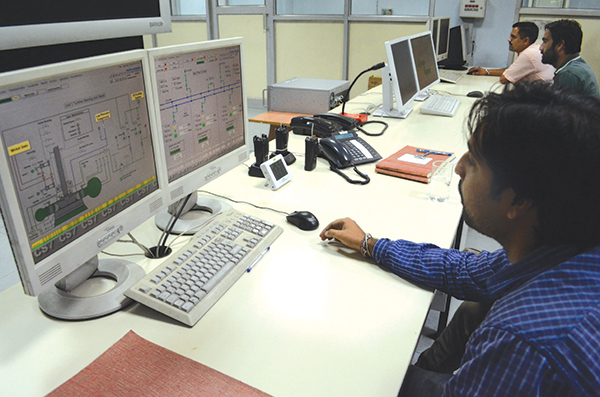After taking off from Salal, NHPC emerged as India’s hydropower behemoth but could never disconnect itself from J&K. Even in Baglihar, it had its own history of getting in and moving out, reports Tasavur Mushtaq

In September 1995, Union Energy Resources Minister N K P Salve visited J&K. He had flown in to oversee the happenings at Dul Hasti that was marred into crisis for a long time and the status of the Uri-I. In Jammu, he addressed a news conference. When a reporter asked him about the Baglihar project and indications in the state’s political parties (albeit not in power) that it will be sought back from the NHPC, Salve on September 26, 1995 was clear. “Centre has decided not to transfer Baglihar to the state government,” Salve said. “Instead, it would be handed over to the private sector after competitive bidding.”
The project identified during the later years of Rajiv Gandhi regime was almost immediately taken up by the NHPC for survey and investigations. By the time it was taken over by the state government somewhere around in 1997, NHPC stated that it had booked an expenditure of Rs 23 crore on its investigations and the preparation for its DPR.
Relations between the state government and the NHPC did not snap with the return of the Baglihar. NHPC and J&K enjoy a long relationship. Right now, it has seven power stations (Salal, Uri-I, Dul Hasti, Uri-II, Sewa-II, Chutak and Nimoo-Bazgo) with cumulative installed capacity of 2009-MWs operational in the state. It is currently implementing 360-MW Kishanganga project while there is not much progress on 1020-MW Bursar. J&K government does not get anything beyond 12 percent of generations as royalty plus one percent for the local development.
Besides, there is also not a major forward movement seen on the Chenab Valley Power Projects, a JV between SPDC, NHPC and PTCI (shareholding is 49:49:2). The JV was mandated to invest Rs 17000 crores and develop 600-MW Kiru, 1000-MW Pakal Dul and 520-MW Kawar.
But NHPC did not stay away from Baglihar, state’s only flagship project in its history. The real negotiations, not known to public, did take place at the peak of state’s desperation to manage financial closure for the project. J&K government and the NHPC have always been in touch but there was a Baglihar related meeting in December 2002.
A new government was a in place and SPDC was facing a crisis for not paying more than Rs 733 crore. Then, Ghulam Nabi Azad, who was heading the coordination committee of the then ruling PDP-Congress alliance, had a detailed meeting the NHPC chairman.
NHPC in that meeting conveyed the corporation would “happily” take over the 450-MW Baglihar, would manage its financial closure but would take “half of the generations” once it completes. “The conditions put forth by the NHPC were not acceptable to the state government for both political and the economic reasons, so the idea was rejected,” a senior officer, privy of the developments, said. “Then we managed the financial closure and the issue never cropped up.” After the project suffered serious damage in 2005 floods, a section in J&K bureaucracy was of the idea of roping in NHPC but it was not permitted to even talk about.
Once Baglihar went into testing, there was a major meeting of top J&K officers in the Prime Minister’s Office. Somebody in that meeting suggested that the project is huge and state government has no experience of handling such a project so somebody should be involved to take care of the Operations and the Maintenance (O&M).
J&K government had reached the stage of seeking an outsider’s help only after playing with the norms. It was eventually exposed by the Comptroller and Auditor General (CAG), two years after SPDC inked an O&M pact with NHPC.
During 2004-05, the CAG says as many as six officers including an executive engineer, an assistant executive engineer, an assistant engineer and three junior engineers, were flown to Germany by the contractors – M/S Voith Siemens and VA – for training. Project owner, the SPDC actually paid Rs 4.62 crore for the training to its contractor and the payment was made in February 2010.
Post training, the CAG says, “two of these officers were repatriated to their parent departments while the services of others could not be utilized as two of them belonged to mechanical and civil disciplines and could not be deployed on power house operational duties.” It is a universal practice that the contractors train the staff for running the plant. It happened in J&K as well but the trained eventually turned out to be blue-eyed – a ‘wrong selection’.
In March 2009 the agreement was inked and by May 2010, the PDC had released Rs 51.58 crores to the NHPC. Under the agreement, the NHPC charged Rs 74.10 crores for running the power house for a year. NHPC took over the project in September 2009. The understanding was that NHPC will run the project for two years till it trains the SPDC staff to run the powerhouse independently. Given the agreement was signed rejecting two offers made by the Voith Siemens, Baglihar’s electro-mechanical contractor, for Rs 36 crores on its core competence and a Hyderabad based firm Precision Engineering Services for the rest of it, there were tensions within and outside the SPDC. The agreement was opposed by SPDC’s on-site engineers saying they are already running the project.
Under pressure, the government finally parted with electrical part and retained the mechanical and civil side with itself. Against a mutually agreed amount of Rs 148.20 crore, the SPDC paid only Rs 70 crore and skipped extending the contract beyond September 2011. Since then, the project is managed by the SPDC engineers and the overall costs have not crossed Rs 12 crore, a year.














